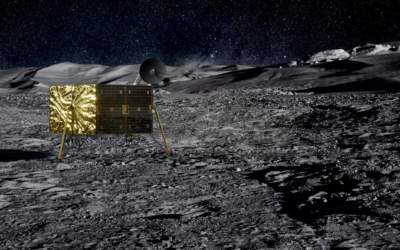Time to take our rocket testbed to the next level! We’re kicking off the development of our newest (and most advanced) vertical takeoff and vertical landing (VTVL) vehicle, Xogdor.
To give you some background, Masten launched one of the first rocket testbeds more than a decade ago. Our suborbital test flights help NASA, defense, and commercial customers validate their technologies aboard our rockets and advance readiness for space. With more than 600 rocket-powered landings (the most in the industry!) across five reusable vehicles, we’ve tested a wide range of payloads from lander vision systems to sample collection vacuums.
Xogdor will be the sixth vehicle in our line of VTVL rockets, enabling us to fly higher, longer, and faster. That means we can test and mature heavier payloads and more complex technologies to enable mission success.
Get the latest on Xogdor below and stay tuned for more updates as we progress on development.
What is Xogdor?
With a growing number of missions planned to the Moon and Mars, more advanced entry, descent, and landing (EDL) technologies and payloads are being developed. These technologies require a more advanced testing vehicle to ensure mission success, and that’s where Xogdor comes in.
Following our NASA Tipping Point award, Xogdor is being developed to expand Masten’s terrestrial tested capacity for government, defense, and commercial customers. For example, the rocket will conduct tests to validate and mature critical Artemis technologies, including hazard detection instruments, precision landing avionics, terrain relative navigation software, and optimal guidance algorithms.
These flight tests will help enable safe, precision landings for robotic and human missions to the Moon and Mars. Xogdor can also be used to test plume surface interactions, payload integration, and payload deployment.
This lean machine will be approximately 27 feet tall and 30 inches wide. We’re building the 5,000 lbf engine in-house with a LOX/Methane turbopump from P3 Technologies.

What’s different about Xogdor?
Higher altitudes & faster speeds: Xogdor will be our fastest rocket yet! It will test descent and landing technologies at high subsonic speeds up to 200 meters per second (447 miles per hour).
Based on customer needs, Xogdor will also be capable of supersonic speeds to fly to the edge of space on a suborbital trajectory. Why is this important? Supersonic speeds of approximately Mach 3.5 are required to cross the Karman Line (100 km above Earth’s mean sea level). By deploying these speeds on Xogdor, we can test payloads in upper atmosphere and near-space environments with reduced gravity.
Ultimately, the closer we can simulate the lunar and Martian environment, the more accurately we can reduce risks and enable mission success with our test flights.
More payload accommodations: Xogdor will have payload capacity of at least 200 kg with accommodations that include power, data storage, thermal control, and ground telemetry. Xogdor can also provide a fully pressurized or vacuum environment for payloads. Since Earth has a thicker atmosphere than the Moon and Mars, Xogdor will have a layer in the control system that minimizes the effects of the atmosphere, such as lift and drag, from the technologies being tested.
These accommodations will allow us to test bigger payloads and conduct more complex experiments, such as micro-gravity and partial-gravity tests that help advance technology readiness for the Moon and Mars.
Point-to-point capabilities: With the ability to fly longer ranges, Xogdor also offers more flexibility when it comes to the launch and landing location. That means we don’t necessarily have to launch and land at our Mojave test site. For example, based on a customer needs, we could launch Xogdor at another test site, such as Spaceport America, and land back in Mojave or vice versa. This opens the door for point-to-point payload transportation.

What isn’t changing from other Masten rockets?
As with all of our VTVL rockets, Xogdor will be capable of aircraft-like operations to conduct multiple flights per day. We use reusable technologies, small operational teams (less than a 10-person crew!), and autonomous GNC software so our rockets can launch, land, refuel, and fly again. Our rockets don’t require maintenance, refurbishment, or replacement of any parts after a nominal flight. We use our proprietary health management software to monitor vehicle health and conduct a quick post-flight analysis before we fly again. This rapid, iterative approach allows us to test early and often and lower the costs associated with each flight.
When will Xogdor be complete?
Masten aims to complete the development of Xogdor by the end of 2022 and will begin test flights as early as 2023. Until then, Masten will continue to test space technologies aboard Xodiac, the fifth vehicle in our line of VTVL rockets. Xodiac has tested a wide range of technologies, including terrain relative navigation, hazard avoidance, and lunar sample collection devices for customers like Draper, JPL, and Honeybee Robotics.
Most recently, we worked with researchers at the University of Central Florida to test plume surface interactions. UCF developed a laser instrument that can scan the area around a lunar lander and detect harmful moondust that could damage spacecraft or lunar infrastructure. We tested the instrument on Xodiac to mimic a lunar landing and quantify the expected damage on simulated lunar regolith.
And don’t forget about Xombie, our first VTVL rocket that has a record 227 flights. It’s currently in retirement, but it had the pleasure of testing some pretty important stuff. Remember the Mars 2020 mission with the Perseverance rover? Xombie tested and validated NASA JPL’s lander vision system that enabled a safe, precision landing.


